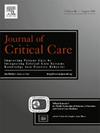Platelet dysfunction in heatstroke-induced coagulopathy: A retrospective observational study
IF 3.2
3区 医学
Q2 CRITICAL CARE MEDICINE
引用次数: 0
Abstract
Purpose
Severe heatstroke is often complicated by disseminated intravascular coagulation (DIC). The aim of this study was to evaluate platelet function assessed through thromboelastography (TEG) at the emergency department (ED) and DIC severity among patients with heatstroke.
Materials and methods
We performed a retrospective single-tertiary hospital cohort study. Patients admitted to an intensive care unit (ICU) with heatstroke were enrolled. Platelet function was evaluated as the difference between citrated functional fibrinogen-maximum amplitude (CFF-MA) and citrated rapid TEG-maximum amplitude (CRT-MA) at the ED. DIC was defined as a score ≥ 4 points based on the Japanese Association of Acute Medicine score.
Results
A total of 31 patients with heatstroke were enrolled. The median platelet count was 18.1 × 104/μL, (interquartile range [IQR]: 12.6–25.0 × 104/μL), and the median platelet function evaluated as CFF-MA-CRT-MA was 34.4 mm (IQR: 27.8–37.8 mm). Among several clinical and TEG-related parameters, the platelet function was strongly correlated with the DIC score (R = −0.63, p < 0.001) and significantly associated with DIC development (area under the receiver operating characteristic curve 0.87 [95 % confidence interval: 0.72–0.99]).
Conclusions
These results suggested that platelet dysfunction occurs in heatstroke-induced DIC, indicating that platelet function evaluation by TEG can provide complementary information and enhance our understanding about the subtypes of heatstroke.
血小板功能障碍在中暑引起的凝血功能障碍:一项回顾性观察研究
目的:重症中暑常并发弥散性血管内凝血(DIC)。本研究的目的是评估急诊科(ED)通过血栓弹性成像(TEG)评估的血小板功能和中暑患者的DIC严重程度。材料和方法我们进行了一项回顾性的单三级医院队列研究。中暑入住重症监护病房(ICU)的患者被纳入研究。血小板功能以ED时柠檬酸功能纤维蛋白原最大振幅(CFF-MA)和柠檬酸快速teg最大振幅(ct -ma)的差异来评估。DIC定义为根据日本急性医学协会评分≥4分。结果共纳入31例中暑患者。血小板计数中位数为18.1 × 104/μL(四分位数间距[IQR]: 12.6 ~ 25.0 × 104/μL), CFF-MA-CRT-MA评价血小板功能中位数为34.4 mm (IQR: 27.8 ~ 37.8 mm)。在多项临床及teg相关参数中,血小板功能与DIC评分密切相关(R = - 0.63, p <;0.001),并与DIC发展显著相关(受试者工作特征曲线下面积0.87[95%可信区间:0.72-0.99])。结论热休克致DIC存在血小板功能障碍,TEG评价血小板功能可提供补充信息,增进对热休克亚型的认识。
本文章由计算机程序翻译,如有差异,请以英文原文为准。
求助全文
约1分钟内获得全文
求助全文
来源期刊

Journal of critical care
医学-危重病医学
CiteScore
8.60
自引率
2.70%
发文量
237
审稿时长
23 days
期刊介绍:
The Journal of Critical Care, the official publication of the World Federation of Societies of Intensive and Critical Care Medicine (WFSICCM), is a leading international, peer-reviewed journal providing original research, review articles, tutorials, and invited articles for physicians and allied health professionals involved in treating the critically ill. The Journal aims to improve patient care by furthering understanding of health systems research and its integration into clinical practice.
The Journal will include articles which discuss:
All aspects of health services research in critical care
System based practice in anesthesiology, perioperative and critical care medicine
The interface between anesthesiology, critical care medicine and pain
Integrating intraoperative management in preparation for postoperative critical care management and recovery
Optimizing patient management, i.e., exploring the interface between evidence-based principles or clinical insight into management and care of complex patients
The team approach in the OR and ICU
System-based research
Medical ethics
Technology in medicine
Seminars discussing current, state of the art, and sometimes controversial topics in anesthesiology, critical care medicine, and professional education
Residency Education.
 求助内容:
求助内容: 应助结果提醒方式:
应助结果提醒方式:


